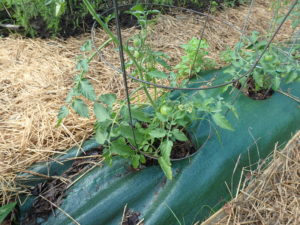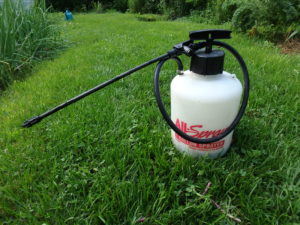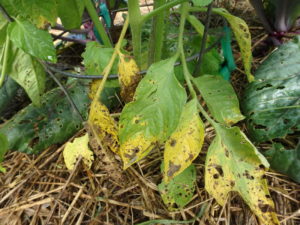How to Minimize Tomato Blight
John Denver introduced me to a Guy Clark song called, “Home Grown Tomatoes” with a refrain that goes, “Only two things money can’t buy. That’s true love and homegrown tomatoes”. How true. I love tomatoes.
Growing disease-free tomatoes is nearly impossible. Usually by this time of the year, gardeners see lower leaves turning yellow and getting spots. Stems turn black early on. Some summers, we only get a few fruits, those tomatoes that started early. Other years we get late blight half way through the season and our plants and fruit turn to disgusting black mush.
So what can we do? According to companies that produce seeds, we can choose varieties of tomatoes that are disease resistant. Breeders using old-fashioned breeding techniques have been successful in breeding resistant hybrids. But some say the flavors are not always as good as the old fashioned heirlooms. I grow both kinds.
This year I am growing ‘Brandy Boy’ (a hybrid produced by Burpee Seeds) that is supposed to taste as good as the heirloom Brandywine, one of my favorite heirloom varieties, and have improved disease resistance.
I know I like ‘Defiant’, a medium-sized hybrid with high resistance to late-blight, produced by Johnny’s Seeds. But Defiant does get early blight, which reduces its production. Still, I grow it each year.
This year my tomato plants are beautiful. Only a few leaves on a few plants showed any signs of yellowing leaves by mid-July. Here are a few things I have done to help prevent tomato diseases.
At planting time I mulched my tomatoes with leaves that I collected last fall. Some fungal disease reside in the soil, and when it rains, or when you water, splash-up sends spores onto the tomato leaves, causing disease. Mulching helps minimize splash-up. Grass cuttings are good, too.
This year I got a soil drench from Gardeners Supply Company called “Root Shield”. This is a bacterial powder that I diluted with water and applied to the soil around each tomato. It is approved for use by organic gardeners. The bacteria attacks the pathogenic fungi in the soil, minimizing the chance of them getting on the tomato plants.
The other bacterial fungicide I applied is called “Serenade”, which I also obtained from Gardeners Supply Co. This contains Bacilius subtilis, a broad spectrum bio-fungicide. It is designed to be sprayed on leaves and stems once a week – and before signs of infection are seen. I have sprayed just twice, not keeping up with the schedule, but will. It’s easy to forget about disease when your plants are disease-free. Once plants are infected, both bio-fungicides are not going to solve the problem.
What else can you do? If you have tomato leaves turning brown, cut them off and put in the household trash, not the compost pile. I did this pretty regularly last year, and I think it helped.
If you get late blight – which basically causes a total meltdown of the plants – quickly bag everything in contractor bags and get everything affected out of the garden. Fortunately, late blight does not survive New England winters. But if you do get it, do not overwinter potatoes, or allow ‘volunteer’ potatoes to grow, as they can carry the blight. Tomatoes and potatoes are in the same plant family.
Fungal diseases often require moisture on the leaves so that fungal hyphae (their root-like appendages) can penetrate the leaves. So do not water at dusk. Water in the morning if possible, and try to keep the leaves dry.
I use a watering wand, not an overhead sprinkler. This is a hand-held watering device – a 30-inch long wand with a sprayer on the end – that allows me to deliver water around the roots, but none on the leaves. In a normal summer I rarely water tomatoes – my soil stays lightly moist most of the time just with rain. But if we go a week or so without rain, I do water.
Many tomato plants will grow taller until the fall over or are pruned back. It’s better to cut off tall branches and keep your plants supported by their cages or stakes. Cutting back plants allows them to spend their energy making tomatoes, not stems and leaves.
As a gardener I am always optimistic. I think this year’s crop of tomatoes from my 37 plants will be the best ever. But I’ll be happy with whatever I get.
Read Henry’s twice-weekly blog posts at https://dailyuv.com/





